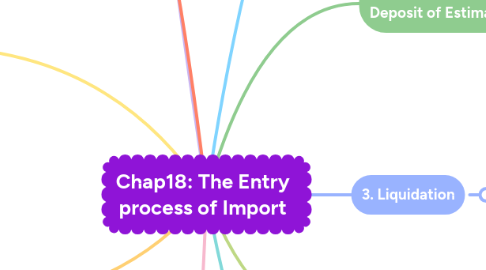
1. Who import?
1.1. Owner, Purchaser, Authorized regular employee, License customs Brokers
2. Marking requirements
2.1. must be legibly marked with the English name of the country of origin unless otherwise indicated.
3. Types of entry
3.1. Entry for consumption
3.1.1. most common; not held for examination is released under bond.
3.2. Entry for warehouse
3.2.1. placed in a customs bonded warehouse; payment of duties deferred
3.3. Entry for transportation in bond
3.3.1. entered for transportation in bond without appraisement to any other port of entry designated by the importer
3.4. Informal entry
3.4.1. commercial entries valued at under $2,000, house-hold and personal effects, and tools of trade.;
3.4.2. not require the same formalities as consumption entry
3.5. Mail entry
3.5.1. imported by mail, not exceeding $2,000 in value
3.5.2. formal entry (consumption entry) is required
3.6. Temporary importation under bond
3.6.1. not imported for sale
3.7. Drawback Entry
3.7.1. A refund of 99 percent of all customs duties is allowed
4. Customs valuation
4.1. The transaction value
4.1.1. Invoice value of the goods as they enter customs.
4.2. The deductive value
4.2.1. Resale price of imported merchandise with deductions for profit and general expenses.
4.3. The computed value
4.3.1. Cost of materials, labor, and overhead in producing the imported product plus profits and general expenses incurred by the producer and value of any items supplied by buyer.
5. HS code
5.1. a commodity description and coding system ; classifies goods according to their essential characters
5.2. common up to 6 digits or can more based on country trading needs
6. 3. Liquidation
6.1. final ascertainment of the duties and drawback accruing on an entry by customs
6.1.1. temporary importation bond entry, transportation in bond, and imports that are subject to immediate exportation
6.2. determination of the value of import
6.2.1. ascertainment of their classification and applicable rate of duty
6.2.1.1. computation of the final amount of duty to be paid
6.2.1.1.1. whether any additional (excess) duty has to be paid (refunded) to importer
7. 1. Filling the entry papers
7.1. Merchandise may be released from its custody
7.2. Assessment and statistical purposes
7.3. 5 documents
7.3.1. Entry manifest or application , special permit for immediate delivery
7.3.2. a commercial invoice or pro forma invoice
7.3.3. a bill of lading, air waybill, or other evidence of right to make entry
7.3.4. a packing list
7.3.5. documents necessary to determine the admissibility of goods
8. 5. Conversion of Currency
9. 2.Release of Merchandise and Deposit of Estimated Duty
9.1. Bonds
9.1.1. secure a customs transaction
9.1.2. Customs bonds (usually 10 percent of the duties, taxes, and fees paid by the importer during the previous thirteen months
9.2. An entry summary for consumption
9.2.1. must be filed and estimated duties deposited within ten working days after release
10. 4. Protests
10.1. Director
10.1.1. CIT
10.1.1.1. Court of Appeals for Federal Circuit
10.1.1.1.1. Supreme court
